My thanks to Jerry Harris, who gave me a copy of the Nexus file
from his (2006) analysis. My file is based on his, changed only in
the addition of the new Xenoposeidon OTU.
|
TEXT-FIG. 1.
A-B, maps indicating location of Ecclesbourne Glen, near Hastings,
East Sussex, England, the probable discovery site of the holotype of
Xenoposeidon proneneukos gen. et sp. nov.
|
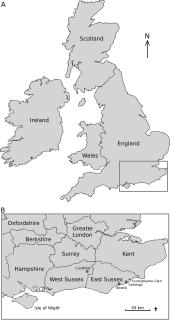
|
|
TEXT-FIG. 2.
Schematic lithostratigraphy of the Wealden indicating the origin of
the holotype of Xenoposeidon proneneukos gen. et
sp. nov. within the Ashdown Beds Formation of the Hastings Beds Group.
|
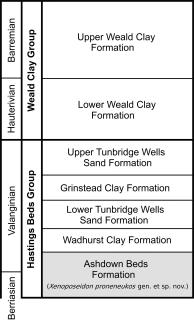
|
|
TEXT-FIG. 3.
Xenoposeidon proneneukos gen. et sp. nov. holotype in A, left
lateral, B, right lateral, C, anterior, and D, posterior TEXT-FIG. 4.
views. Scale bar represents 200 mm.
|
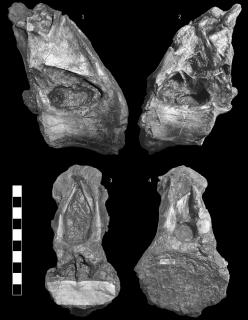
|
|
TEXT-FIG. 4.
Interpretive drawing of Xenoposeidon proneneukos gen. et sp.
nov. holotype in A, left lateral, B, right lateral, C, anterior, and
D, posterior views. Scale bar represents 200 mm. Breakage is
indicated by diagonal hatching. The PPDL (preserved only on the left
side) is a sheet of bone projecting anterolaterally from the neural
arch with its anterolateral margin running dorsoventrally, but which
is broken off just dorsal to the parapophysis.
|
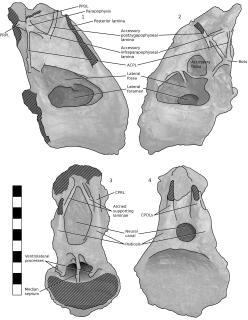
|
|
TEXT-FIG. 5.
Xenoposeidon proneneukos gen. et sp. nov. holotype, mid to
posterior dorsal vertebra BMNH R2095, speculative reconstruction, in
left lateral view. The location of the prezygapophyses,
postzygapophyses and diapophyses are inferred with some confidence
from the preserved laminae; the neural spine is based on an idealized
slender neosauropod neural spine. Scale bar represents 200 mm.
|
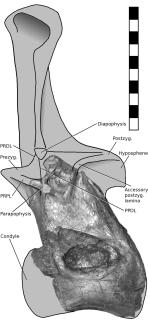
|
|
TEXT-FIG. 6.
Phylogenetic relationships of Xenoposeidon proneneukos,
produced using PAUP* 4.0b10 on the matrix of Harris (2006) augmented
by Xenoposeidon, having 31 taxa and 331 characters. A, strict
consensus of 1089 most parsimonious trees (length, 785; CI, 0.5248;
RU, 0.6871, RC = 0.3606). B, 50 per cent majority rule consensus.
Clade names are positioned to the right of the branches that they
label; occurrence percentages are positioned to the left of these
branches.
|
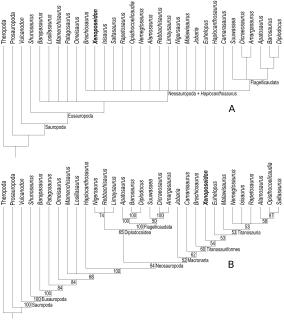
|
I am providing these specimen photos, with no description or
comment, for the benefit of anyone who wants to compare
Xenoposeidon with other taxa and needs more detail than is
in the paper.





